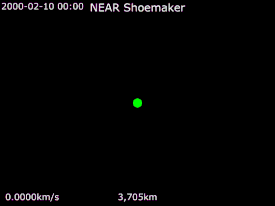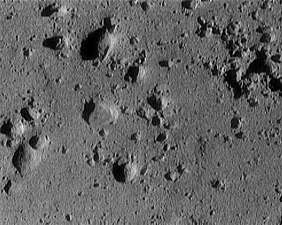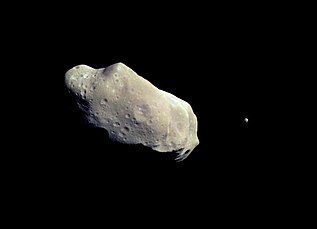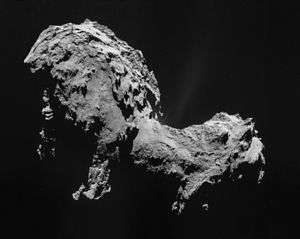NEAR Shoemaker
The Near Earth Asteroid Rendezvous – Shoemaker (NEAR Shoemaker), renamed after its 1996 launch in honor of planetary scientist Eugene Shoemaker, was a robotic space probe designed by the Johns Hopkins University Applied Physics Laboratory for NASA to study the near-Earth asteroid Eros from close orbit over a period of a year. The mission succeeded in closing in with the asteroid and orbited it several times, finally terminating by touching down on the asteroid on February 12, 2001.
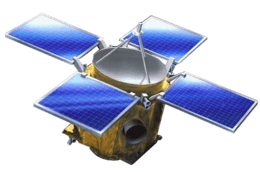 Model of the NEAR Shoemaker spacecraft | |
| Mission type | Orbiter (433 Eros) |
|---|---|
| Operator | NASA · APL |
| COSPAR ID | 1996-008A |
| SATCAT no. | 23784 |
| Website | near |
| Mission duration | 5 years, 21days |
| Spacecraft properties | |
| Launch mass | ~800 kilograms (1,800 lb) |
| Dry mass | 487 kilograms (1,074 lb) |
| Power | 1,800 W |
| Start of mission | |
| Launch date | February 17, 1996 20:43:27 UTC (24 years, 5 months and 30 days ago) |
| Rocket | Delta II 7925-8 |
| Launch site | Cape Canaveral LC-17B |
| End of mission | |
| Last contact | February 28, 2001 ~00:00 UTC (19 years, 5 months and 19 days ago) |
| Landing date | February 12, 2001 20:01 UTC (19 years, 6 months and 4 days ago) |
| Landing site | South of Himeros crater, 433 Eros |
| Flyby of 253 Mathilde | |
| Closest approach | June 27, 1997 12:56 UTC (23 years, 1 month and 20 days ago) |
| Distance | 1,212 kilometers (753 mi) |
| 433 Eros orbiter | |
| Orbital insertion | February 14, 2000 15:33 UTC (20 years, 6 months and 2 days ago) |
| Orbits | 230 orbits[1] |
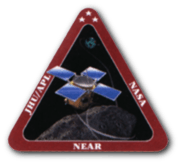 Official insignia of the NEAR Shoemaker mission Discovery program | |
The primary scientific objective of NEAR was to return data on the bulk properties, composition, mineralogy, morphology, internal mass distribution and magnetic field of Eros. Secondary objectives include studies of regolith properties, interactions with the solar wind, possible current activity as indicated by dust or gas, and the asteroid spin state. This data will be used to help understand the characteristics of asteroids in general, their relationship to meteoroids and comets, and the conditions in the early Solar System. To accomplish these goals, the spacecraft was equipped with an X-ray/gamma-ray spectrometer, a near-infrared imaging spectrograph, a multi-spectral camera fitted with a CCD imaging detector, a laser rangefinder, and a magnetometer. A radio science experiment was also performed using the NEAR tracking system to estimate the gravity field of the asteroid. The total mass of the instruments was 56 kg, and they required 80 W power.
Development
A previous plan for the mission was for it to go to 4660 Nereus and do a flyby of 2019 Van Albada en route.[2] In January 2000 it would rendezvous with Nereus but instead of staying it would visit multiple asteroids and comets.[2] Some of the choices that were discussed were 2P/Encke, 433 Eros (that became the mission's primary target), 1036 Ganymed, 4 Vesta, and 4015 Wilson–Harrington.[2] The Small-Body Grand Tour was a plan for visiting two asteroids and two comets over a span of a decade with the spacecraft.[2]
Mission profile
.jpg)
Summary
The primary goal of the mission was to study the near-Earth asteroid 433 Eros from orbit for approximately one year. Eros is an S-type asteroid approximately 13 × 13 × 33 km in size, the second largest near-Earth asteroid. Initially the orbit was circular with a radius of 200 km. The radius of the orbit was brought down in stages to a 50 × 50 km orbit on April 30, 2000 and decreased to 35 × 35 km on July 14, 2000. The orbit was raised over succeeding months to a 200 × 200 km orbit and then slowly decreased and altered to a 35 × 35 km retrograde orbit on December 13, 2000. The mission ended with a touchdown in the "saddle" region of Eros on February 12, 2001.
Some scientists claim that the ultimate goal of the mission was to link Eros, an asteroidal body, to meteorites recovered on Earth. With sufficient data on chemical composition, a causal link could be established between Eros and other S-type asteroids, and those meteorites believed to be pieces of S-type asteroids (perhaps Eros itself). Once this connection is established, meteorite material can be studied with large, complex, and evolving equipment, and the results extrapolated to bodies in space. NEAR-Shoemaker did not prove or disprove this link to the satisfaction of scientists.
Between December 1999 and February 2001 NEAR Shoemaker used its gamma-ray spectrometer to detect gamma-ray bursts as part of the InterPlanetary Network.[3]
The journey to Mathilde
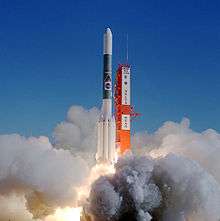
After launch on a Delta 7925-8 (a Delta II launch vehicle with nine strap-on solid-rocket boosters and a Star 48 (PAM-D) third stage) and exit from Earth orbit, NEAR entered the first part of its cruise phase. NEAR spent most of the cruise phase in a minimal activity "hibernation" state, which ended a few days before the flyby of the 61 km diameter asteroid 253 Mathilde.[4]
_mathilde_crop.jpg)
On June 27, 1997, NEAR flew by Mathilde within 1200 km at 12:56 UT at 9.93 km/s, returning imaging and other instrument data. The flyby produced over 500 images, covering 60% of Mathilde's surface,[5] as well as gravitational data allowing calculations of Mathilde's dimensions and mass.[6]
The journey to Eros
On July 3, 1997, NEAR executed the first major deep space maneuver, a two-part burn of the main 450 N thruster. This decreased the velocity by 279 m/s and lowered perihelion from 0.99 AU to 0.95 AU. The Earth gravity assist swingby occurred on January 23, 1998 at 7:23 UT. The closest approach was 540 km, altering the orbital inclination from 0.5 to 10.2 degrees, and the aphelion distance from 2.17 to 1.77 AU, nearly matching those of Eros. Instrumentation was active at this time.[4]
Failure of first attempt at orbital insertion
The first of four scheduled rendezvous burns was attempted on December 20, 1998 at 22:00 UT. The burn sequence was initiated but immediately aborted. The spacecraft subsequently entered safe mode and began tumbling. The spacecraft's thrusters fired thousands of times during the anomaly, which expended 29 kg of propellant reducing the program's propellant margin to zero. This anomaly almost resulted in the loss of the spacecraft due to lack of solar orientation and subsequent battery drain. Contact between the spacecraft and mission control could not be established for over 24 hours. The root cause of this incident has not been determined, but software and operational errors contributed to the severity of the anomaly.[7]
The original mission plan called for the four burns to be followed by an orbit insertion burn on January 10, 1999, but the abort of the first burn and loss of communication made this impossible. A new plan was put into effect in which NEAR flew by Eros on December 23, 1998 at 18:41:23 UT at a speed of 965 m/s and a distance of 3827 km from the center of mass of Eros. Images of Eros were taken by the camera, data were collected by the near IR spectrograph, and radio tracking was performed during the flyby. A rendezvous maneuver was performed on January 3, 1999 involving a thruster burn to match NEAR's orbital speed to that of Eros. A hydrazine thruster burn took place on January 20 to fine-tune the trajectory. On August 12 a two-minute thruster burn slowed the spacecraft velocity relative to Eros to 300 km/h.[4]
Orbital insertion
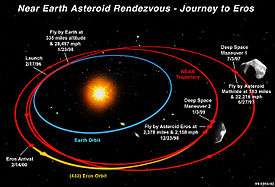
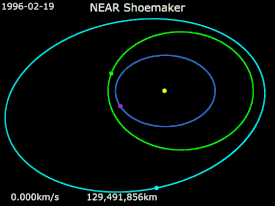
NEAR Shoemaker; 433 Eros; Earth; 253 Mathilde ; Sun;
Orbital insertion around Eros occurred on February 14, 2000 at 15:33 UT (10:33 AM EST) after NEAR completed a 13-month heliocentric orbit which closely matched the orbit of Eros. A rendezvous maneuver was completed on February 3 at 17:00 UT, slowing the spacecraft from 19.3 to 8.1 m/s relative to Eros. Another maneuver took place on February 8 increasing the relative velocity slightly to 9.9 m/s. Searches for satellites of Eros took place on January 28 and February 4 and 9; none were found. The scans were for scientific purposes and to mitigate any chances of collision with a satellite. NEAR went into a 321×366 km elliptical orbit around Eros on February 14. The orbit was slowly decreased to a 35 km circular polar orbit by July 14. NEAR remained in this orbit for 10 days and then was backed out in stages to a 100 km circular orbit by September 5, 2000. Maneuvers in mid-October led to a flyby of Eros within 5.3 km of the surface at 07:00 UT on October 26.[4]
Orbits and landing
Following the flyby NEAR moved to a 200 km circular orbit and shifted the orbit from prograde near-polar to a retrograde near-equatorial orbit. By December 13, 2000 the orbit was shifted back to a circular 35 km low orbit. Starting on January 24, 2001 the spacecraft began a series of close passes (5 to 6 km) to the surface and on January 28 passed 2 to 3 km from the asteroid. The spacecraft then made a slow controlled descent to the surface of Eros ending with a touchdown just to the south of the saddle-shaped feature Himeros on February 12, 2001 at approximately 20:01 UT (3:01 p.m. EST). To the surprise of the controllers, the spacecraft was undamaged and operational after the landing at an estimated speed of 1.5 to 1.8 meters per second (thus becoming the first spacecraft to soft-land on an asteroid).[8] After receiving an extension of antenna time on the Deep Space Network, the spacecraft's gamma-ray spectrometer was reprogrammed to collect data on Eros' composition from a vantage point about 4 inches (100 mm) from the surface where it was ten times more sensitive than when it was used in orbit.[9] This increase in sensitivity was in part due to the increased ratio of the signal from Eros compared to noise generated by the probe itself.[3] The impact of cosmic rays on the sensor was also reduced by about 50%.[3]
At 7 p.m. EST on February 28, 2001 the last data signals were received from NEAR Shoemaker before it was shut down. A final attempt to communicate with the spacecraft on December 10, 2002 was unsuccessful. This was likely due to the extreme −279 °F (−173 °C, 100 K) conditions the probe experienced while on Eros.[10]
Spacecraft and subsystems

The spacecraft has the shape of an octagonal prism, approximately 1.7 m on a side, with four fixed gallium arsenide solar panels in a windmill arrangement, a fixed 1.5 m X-band high-gain radio antenna with a magnetometer mounted on the antenna feed, and an X-ray solar monitor on one end (the forward deck), with the other instruments fixed on the opposite end (the aft deck). Most electronics were mounted on the inside of the decks. The propulsion module was contained in the interior. The decision to mount instruments on the body of the spacecraft rather than using booms resulted in the gamma-ray spectrometer needing to be shielded from noise generated by the craft.[3] A bismuth germanate shield was used although this proved only moderately effective.[3]
The craft was three-axis stabilized and used a single bipropellant (hydrazine / nitrogen tetroxide) 450 newton (N) main thruster,[11] and four 21 N and seven 3.5 N hydrazine thrusters for propulsion, for a total delta-V potential of 1450 m/s. Attitude control was achieved using the hydrazine thrusters and four reaction wheels. The propulsion system carried 209 kg of hydrazine and 109 kg of NTO oxidizer in two oxidizer and three fuel tanks.[4]
Power was provided by four 1.8 by 1.2 meter gallium arsenide solar panels which could produce 400 watts at 2.2 AU (329,000,000 km), NEAR's maximum distance from the Sun, and 1800 W at one AU (150,000,000 km). Power was stored in a nine ampere-hour, 22-cell rechargeable super nickel-cadmium battery.[4]
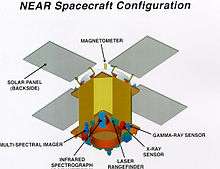
Spacecraft guidance was achieved through the use of a sensor suite of five digital solar attitude detectors, an inertial measurement unit (IMU), and a star tracker camera pointed opposite the instrument pointing direction. The IMU contained hemispherical resonator gyroscopes and accelerometers. Four reaction wheels (arranged so that any three can provide complete three-axis control) were used for normal attitude control. The thrusters were used to dump angular momentum from the reaction wheels, as well as for rapid slew and propulsive maneuvers. Attitude control was to 0.1 degree, line-of-sight pointing stability is within 50 microradians over one second, and post-processing attitude knowledge is to 50 microradians.[4]
The command and data handling subsystem was composed of two redundant command and telemetry processors and solid state recorders, a power switching unit, and an interface to two redundant 1553 standard data buses for communications with other subsystems. NEAR is the first APL spacecraft to use significant numbers of plastic encapsulated microcircuits (PEMs). NEAR is the first APL spacecraft to use solid-state data recorders for mass storage—previous APL spacecraft used magnetic tape recorders or magnetic cores.[12]
The solid state recorders are constructed from 16 Mbit IBM Luna-C DRAMs. One recorder has 1.1 gigabits of storage, the other has 0.67 gigabits.[4]
The NEAR mission was the first launch of NASA's Discovery Program, a series of small-scale spacecraft designed to proceed from development to flight in under three years for a cost of less than $150 million. The construction, launch, and 30-day cost for this mission is estimated at $122 million. The final total mission cost was $224 million which consisted of $124.9 million for spacecraft development, $44.6 million for launch support and tracking, and $54.6 million for mission operations and data analysis.[1]
References
- "NEAR: FAQ". Applied Physics Lab.
- Extended-mission opportunities for a Discovery-class asteroid rendezvous mission
- Trombka, J. I.; Nittler, L. R.; Starr, R. D.; Evans, L. G.; et al. (2001). "The NEAR-Shoemaker x-ray/gamma-ray spectrometer experiment: Overview and lessons learned". Meteoritics & Planetary Science. 36 (12): 1605–1616. Bibcode:2001M&PS...36.1605T. doi:10.1111/j.1945-5100.2001.tb01852.x.
- "NEAR Shoemaker". NASA Space Science Data Coordinated Archive. Retrieved February 5, 2019.
- Williams, David R. (December 18, 2001). "NEAR Flyby of Asteroid 253 Mathilde". NASA. Retrieved August 10, 2006.
- D. K. Yeomans; et al. (1997). "Estimating the mass of asteroid 253 Mathilde from tracking data during the NEAR flyby". Science. 278 (5346): 2106–9. Bibcode:1997Sci...278.2106Y. doi:10.1126/science.278.5346.2106. PMID 9405343. Retrieved August 29, 2007.
- "The NEAR Rendezvous Burn Anomaly of December 1998" (PDF). Final Report of the NEAR Anomaly Review Board. November 1999. Retrieved February 2, 2017.
- Siddiqi, Asif A. (2018). Beyond Earth: A Chronicle of Deep Space Exploration, 1958–2016 (PDF). The NASA history series (second ed.). Washington, DC: NASA History Program Office. p. 2. ISBN 9781626830424. LCCN 2017059404. SP2018-4041.
- Worth, Helen (February 28, 2001). "The End of an Asteroidal Adventure: NEAR Shoemaker Phones Home for the Last Time". Applied Physics Lab.
- "NEAR Shoemaker's Silent Treatment". Applied Physics Laboratory. February 23, 2001.
- Williams, David R. (February 8, 2000). "NEAR Mission Profile". NASA Goddard Space Flight Center. Retrieved February 5, 2019.
- Ronald K. Burek. "The NEAR Solid-State Data Recorders". Johns Hopkins APL Technical Digest. 1998
- Text adapted from public domain NASA webpage.
- Trombka JI; Squyres SW; Bruckner J; Boynton WV; et al. (2000). "The elemental composition of asteroid 433 Eros: Results of the NEAR-Shoemaker x-ray spectrometer". Science. 289 (5487): 2101–2105. Bibcode:2000Sci...289.2101T. doi:10.1126/science.289.5487.2101. PMID 11000107.
- Zuber MT; Smith DE; Cheng AF; Garvin JB; et al. (2000). "The shape of 433 Eros from the NEAR-Shoemaker Laser Rangefinder". Science. 289 (5487): 2097–2101. Bibcode:2000Sci...289.2097Z. doi:10.1126/science.289.5487.2097. PMID 11000106.
- Yeomans DK; Antreasian PG; Barriot JP; Chesley SR; et al. (2000). "Radio science results during the NEAR-Shoemaker spacecraft rendezvous with Eros". Science. 289 (5487): 2085–2088. Bibcode:2000Sci...289.2085Y. doi:10.1126/science.289.5487.2085. PMID 11000104.
![]()
External links
- NEAR Shoemaker Profile by NASA's Solar System Exploration
- NSSDC Master Catalog: Spacecraft - NEAR Shoemaker
- NASA GSFC: NEAR Shoemaker, Near Earth Asteroid Rendezvous
- Official NEAR Mission Site (Johns Hopkins Applied Physics Laboratory)
- Near Earth Asteroid Rendezvous
- NEAR Mission Archive at the NASA Planetary Data System, Small Bodies Node
